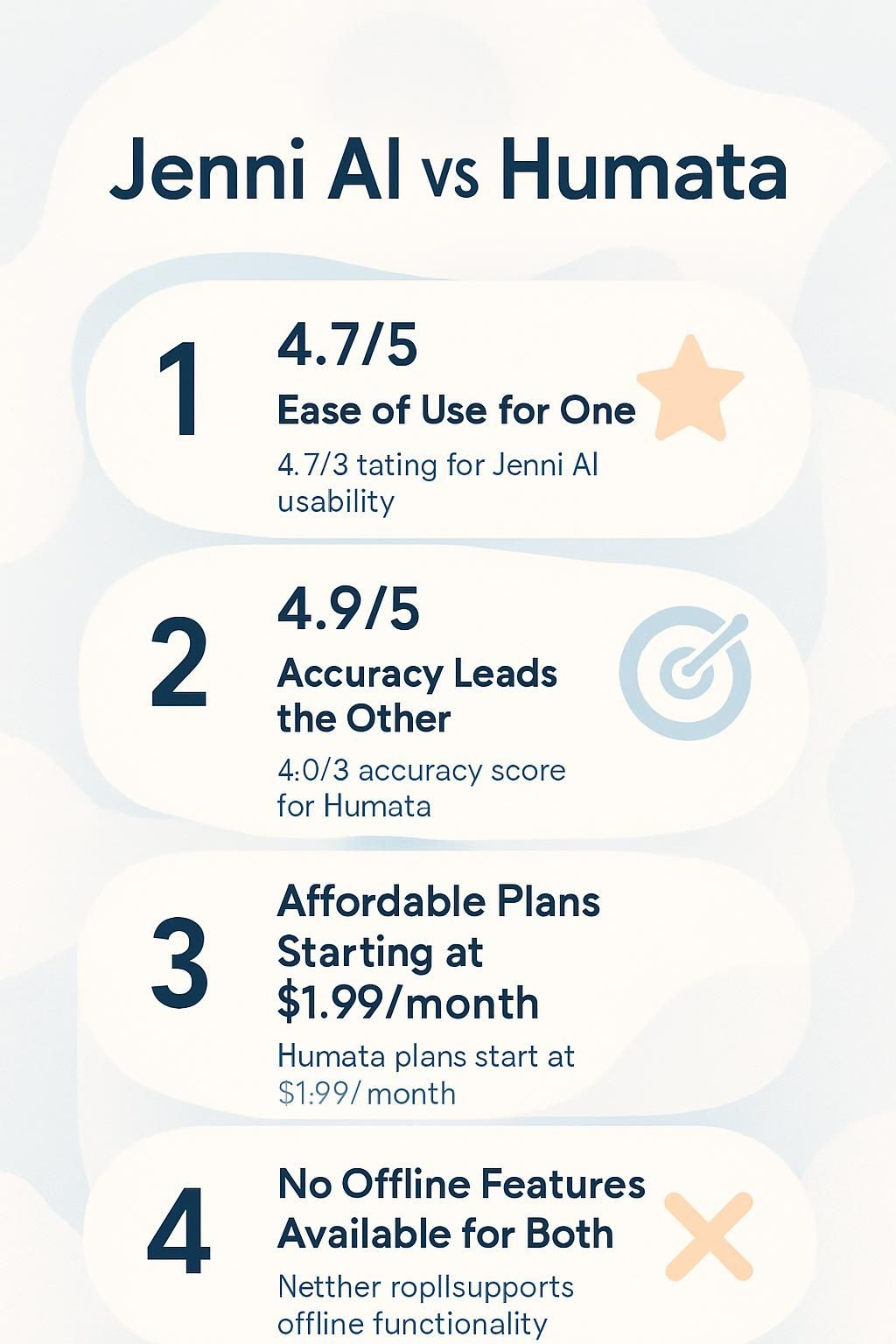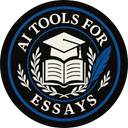Struggling to choose the best AI writing tool for research or essays? Jenni AI and Humata are two smart tools that aim to make academic work easier. This blog breaks down their features, strengths, and differences to help you pick the right one.
Keep reading to find your perfect match!
Key Takeaways
- Jenni AI simplifies academic writing with tools like citation generation (APA, MLA) and plagiarism checking. It has a user-friendly interface rated 4.7/5 and is ideal for improving research papers.
- Humata excels at summarizing large documents quickly using GPT-based models. It scores 4.9/5 in accuracy, making it perfect for analyzing peer-reviewed papers or literature reviews.
- Both tools are reliable but differ in focus: Jenni AI helps write and edit; Humata analyzes data-rich files fast with features like semantic search and OCR.
- Jenni AI is cost-efficient with discounts, while Humata offers flexible plans starting from $1.99/month, plus free options for basic use.
- Neither tool generates full essays yet lacks offline support, which could limit usability for some users needing higher originality or creative input.

Key Features of Jenni AI
Jenni AI makes writing smarter, faster, and easier with its AI-powered text editor. Its tools for academic research help users save time and improve their work quality.
How does Jenni AI provide advanced writing assistance?
Jenni AI helps with writing by offering smart suggestions and prompts. It doesn’t write entire essays but guides users through their work, making it easier to stay focused. Its assistance is perfect for research papers, where accuracy matters most.
With a 4.8/5 reliability rating, it’s trusted for academic tasks.
The tool also supports citation generation in various styles like APA or MLA. This feature saves time while ensuring proper formatting of sources. Users can edit content directly within the AI-powered text editor, which speeds up the writing process without losing quality.
What academic tools does Jenni AI offer?
Jenni AI offers a set of advanced academic tools. It helps write, edit, and cite research papers with precision. Users can enjoy features like citation generation that supports various styles such as APA or MLA.
A plagiarism checker is also available to ensure originality in content. Its grammar checker improves language quality instantly.
This platform assists Ph.D. students, researchers, or even undergrads by providing literature review suggestions customized to their work. It integrates smoothly with popular formats like Word documents and Google Docs for convenience.
Now, here’s why its interface feels so easy to use!
Why is Jenni AI’s interface user-friendly?
The interface feels simple and smooth. Users find their tools fast without confusion. It has an Ease of Use rating of 4.7/5, proving its design works well for most people.
Search bars and menus are clear, so even complex tasks like citation generation or text summarization don’t feel hard. Everything feels in reach—whether you’re exploring research papers, editing PDFs, or using AI writing tools.
Key Features of Humata
Humata excels at breaking down complex research papers into bite-sized insights. It uses smart tools to make sorting through large PDF files quick and smooth.
How does Humata summarize documents effectively?
Humata uses AI tools to process and summarize large documents quickly. It scans PDF files, research papers, and other data-rich text to pull out the most important points. The tool reads through complex information in seconds, saving users hours of manual work.
Its accuracy comes from advanced machine learning models like GPT-3. These models help Humata find patterns, key ideas, and insights that matter most. With a performance rating of 4.8/5 for speed alone, it ensures smooth document processing for tasks like academic research or literature reviews.
What AI tools does Humata use for comparisons?
Humata uses advanced AI models like OpenAI’s GPT for smart comparisons. These tools scan large data sets, research papers, and PDF documents in seconds. They analyze complex information with high accuracy.
The system relies on natural language processing (NLP) to compare text easily. It finds patterns, contrasts ideas, and highlights differences effectively. Optical character recognition (OCR) also helps process scanned files quickly.
This makes working with academic research or peer-reviewed papers smooth for users.
How does Humata analyze research documents?
Humata uses advanced AI tools to break down research documents. It processes complex information quickly, scanning for key ideas and patterns. With its semantic search abilities, it identifies essential data from large texts or peer-reviewed papers in minutes.
This makes reviewing dissertations or academic research faster and easier.
AI-powered solutions like tokenization and annotations help highlight critical points. The platform also cross-references data across multiple sources to provide deeper insights. Its focus on accuracy rates of 4.9/5 ensures reliable analysis, saving researchers both time and effort during literature reviews or document processing tasks.
Jenni AI vs. Humata: Core Comparisons
Choosing between Jenni AI and Humata depends on how you value ease, precision, and adaptability—so stick around to see which tool fits your needs better!
Which tool is easier to use?
Both tools score highly on ease of use, with a rating of 4.7/5. Jenni AI offers a clean interface that feels intuitive, even for beginners. Its layout simplifies writing and research tasks without overwhelming users.
Humata also keeps things simple but adds extra focus to document processing features. It handles large files smoothly and requires minimal effort to upload or analyze data. Both tools excel in making complex tasks feel straightforward for users at any level.
Which tool is more accurate for academic writing?
Humata AI rates higher in accuracy at 4.9/5, slightly edging out Jenni AI’s 4.8/5 score. This small difference can matter for academic research where precision is king. Humata excels by analyzing peer-reviewed papers and generating concise summaries without losing key points.
Jenni AI still holds its ground with advanced citation tools and strong grammar checks. It also rephrases complex information into simpler text well, helping researchers save time.
Both tools are reliable, but Humata’s document analysis might give it the upper hand for complex tasks like literature reviews or sifting through large databases of research papers.
How do they perform in document summarization?
Jenni AI offers writing help but lacks strong document summarization features. It focuses more on editing, citations, and improving writing clarity. While it can handle smaller text summaries, large or complex documents may require alternative tools.
Humata AI excels in this area with a rating of 4.9/5 for functionality. Its AI processes long research papers and extensive databases efficiently. It pulls key points quickly without losing important context, making it ideal for academic research or analyzing peer-reviewed papers.
Which offers better customization and flexibility?
Both Jenni AI and Humata score 4.9/5 for customization and flexibility. Users can adapt these tools to fit academic research or creative workflows. Adjustable settings allow smooth integration, meeting various writing needs.
Jenni AI shines with its personalized suggestions for academic papers or literature reviews. On the other hand, Humata excels in tailoring document summaries for efficient analysis of complex information.
Both offer seamless compatibility, earning a high rating for adaptability across tasks.
Moving on to their strengths and weaknesses…
Pros and Cons of Jenni AI and Humata
Both tools shine in different areas, offering valuable help for academic work. While one might ace document analysis, the other may impress with its AI writing tools.
What are the strengths of Jenni AI?
Jenni AI shines as a top-notch academic research assistant. It offers sharp writing assistance and integrates well with other tools. Its high cost-efficiency rating, 4.9/5, makes it wallet-friendly for students and researchers alike.
Discounts further help reduce expenses, making advanced features affordable.
Its strong data privacy score of 4.8/5 guarantees safe handling of documents. The interface is simple yet powerful, packed with AI-powered text editing options for citation generation and plagiarism detection without hassle.
This tool is perfect for processing peer-reviewed papers or conducting literature reviews efficiently.
Next section: **What are the strengths of Humata?**
What are the strengths of Humata?
Humata excels in summarizing and analyzing large documents quickly. With a high accuracy rating of 4.9/5, it processes complex information efficiently. Its AI tools help break down research papers, making it ideal for academic use.
The platform is perfect for those working with peer-reviewed papers or conducting a literature review.
The flexible pricing adds to its appeal. Students can access plans as low as $1.99/month, while free options are also available. Humata’s speed and performance boast a strong 4.8/5 score, ensuring tasks get done fast without compromising quality.
It’s an excellent choice for anyone seeking reliable AI-powered solutions for document analysis and research support!
What limitations do both tools have?
Both Jenni AI and Humata have challenges. They lack creativity and originality compared to human writing. Users relying too much on them risk producing work that feels robotic or repetitive.
Neither tool generates full essays, which may limit their usefulness for some academic needs.
Their pricing can also be a hurdle. For example, Humata’s team plan costs $49 per user each month, making it expensive for larger groups. Overreliance on these tools could lead to weaker critical thinking skills in users over time.
Both require internet access, so offline use isn’t possible either.
Comparison with Other Tools (e. g. , Scribbr)
Scribbr stands out with its citation tools, but how do Jenni AI and Humata stack up in handling academic tasks?
How do Jenni AI and Humata compare to Scribbr?
Jenni AI and Humata rely on AI-powered writing tools, while Scribbr emphasizes citation generation and plagiarism checking. Jenni AI shines in crafting academic content, offering an intuitive interface for students or researchers.
It simplifies tasks like rephrasings and referencing without overwhelming its users. Humata excels at document processing, especially summarizing research papers with complex information.
Scribbr focuses more on accuracy in citation styles such as APA or MLA. Its tools handle peer-reviewed papers thoroughly but lack other features like searching large documents quickly.
Unlike Scribbr, both Jenni AI and Humata prioritize analyzing data across huge files efficiently by using advanced technology like semantic search engines.
Conclusion
Both Jenni AI and Humata shine in their own ways. Each caters to different needs, whether it’s writing support or document analysis. Choosing between them depends on what you value most—simplicity, depth, or accuracy.
Both tools prove that AI can truly change how we tackle academic work. The right choice is the one that fits your workflow best!
FAQs
1. What is the main difference between Jenni AI and Humata?
Jenni AI focuses on being an AI-powered text editor and writing tool, helping with tasks like citation generation and academic research. Humata specializes in document analysis, making it ideal for searching large documents or processing complex information.
2. Can both tools assist with academic research?
Yes, both can act as a research assistant. Jenni AI helps with literature reviews and peer-reviewed papers, while Humata excels at analyzing data from databases or lengthy documents.
3. Are these tools secure for sensitive data?
Both prioritize data security using technologies like SSL/TLS encryption to protect user information during document processing or web searches.
4. Do they help prevent plagiarism in writing?
Yes, Jenni AI includes features like plagiarism checkers to ensure content isn’t plagiarized. Both tools also support transparent workflows when handling ai-generated outputs.
5. How do they compare for users working on complex projects?
Humata works well for digging into detailed reports or technical files due to its strong focus on document analysis and semantic scholar integration. Jenni AI shines when simplifying intellect-based tasks like drafting ideas or editing thoughts clearly.
6. Are there subscription options available for these tools?
Yes, both offer subscriptions tailored to different needs; you can explore their checkout pages to find plans suitable for students, researchers, or even professional data analysts at institutions like Simon Fraser University!
